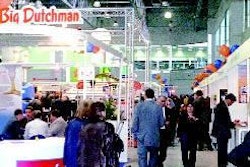While publicity given to outbreaks of avian influenza (AI) impacted adversely on consumption in the Russian Federation, both the poultrymeat and egg sectors are now headed on an expansion course. However, a limiting factor to growth could be the rate of development in the feed and processing sectors.
Outbreaks of AI late in 2005 and early in 2006, and more particularly the publicity given to them in the Russian media, led to a sharp reduction in the consumption of chicken. However, positive trends emerged as a result of a perceived strengthening of veterinary control and less publicity about the disease in the press, on radio and television.
Chicken meat output in 2005 is currently put at 1.35 million tonnes (mt) while further gains last year and in early 2007 will likely boost the total to more than 1.5mt.
According to a USDA Gain report, broilers account for around 87% of total poultrymeat production and that about half of all domestically produced chicken is traded as fresh or chilled product. Poultry currently comprises 35% of the total Russian meat market of which 35% are whole birds, 37% are chicken leg quarters and 28% are processed products.
However, the report expresses the view that the growth in production at the current high rate can only be maintained if the related ancillary businesses particularly feed production and processing can also become more developed.
Chicken slaughterings (including culled layers) in 2005 reached a record 964 million compared with 856m in the previous year and only 612m back in 2000 (see table).
The average eviscerated weight has increased during the six years from 1.23kg to 1.4kg/bird.
In 2005, it is considered that just 10% of total poultry output was provided by facilities where the average bird weight gain was more than 50g/day, the birds being slaughtered at 35 days of age, with a feed conversion of 1.6-1.7.
During the first seven months of 2006, Russia's poultrymeat imports contracted from around just over 702,000t to around 690,000t, although the estimate for the year at 1.24mt points to a gain of 4%. However, the latest forecast for 2007 at 1.15mt shows a 7% drop. Broiler growers are continuing to put pressure on the government to limit competition by applying import restrictions. The bulk of imports comprise chicken leg quarters from the USA.
Thailand's largest poultry exporter, Charoen Pokphand Foods, is reported to be building several poultry facilities in the Russian Federation, including in the Moscow area.
Consumer demand for poultry has decreased noticeably since the outbreaks of AI were first reported in 2005 although the estimates of the cutback range widely from 10 to 20%!
Russians are not used to eating turkeymeat as commercial production has only recently commenced, with annual output rising from around 17,000 tonnes in 2005 to the estimate of around 21,000t for this year. Imports amount to about 100,000t a year hence, annual domestic consumption is in the region of 120,000t.
According to a USDA Gain report, a new system of broiler production is being introduced in some regions. A mini-facility equipped with up-to-date European equipment is being constructed in Ulyanovsk region. One person can run this mini-operation, which is completely automated and computerised including climate control and manure removal. Each unit is expected to produce about 700t of broilermeat annually. The birds will be slaughtered at 42 days of age, weighing around 2.5kg. Some 25 such farms will be built in the region and it is understood that the Ministry of Agriculture will apply this approach throughout several regions.
Investment in eggs
There had been a lot of investment in the private sector of Russia's egg industry in recent years. While the laying flock has actually declined from almost 129 million in 2000 to the current level of around 120m, improvements in yields/bird have maintained total egg output at around the 2.0mt level.
Egg consumption has also been hit by concerns over AI, such that it is currently in the region of 242 eggs/person compared with 245 back in 2003. However, one forecast for 2010 puts this figure in excess of 300 eggs/person!
There are some 425 egg farms, which can also be called egg plants because they combine production with a processing facility. The estimate of egg production for 2006 was 38.0 billion (b) eggs, which compared with 35.8b in 2004. Of the 2006 total, industrial units produced 29.0b. By 2010, output is forecast to reach 47.0b, of which 37.0b are expected to come from commercial enterprises.
Egg yields/bird have improved annually in the past decade along with feed conversion. Last year, the majority (57%) of farms reported yields of between 300 and 330 eggs/hen/year. Some 17% averaged more than 330 eggs, 18% between 270 and 300 and only 8% yielded fewer than 270.
Looking at the market split, some 48% of eggs were sold as ordinary table eggs to retailers, a further 40% were processed and value-added in some way, 10% were converted to dried egg products and just 2% were sold as liquid pasteurised eggs.
H5N1 threatens Russia again
At the time of writing, the H5N1 highly pathogenic AI virus is again raising its ugly head in Russia. In late February, there had been three outbreaks in flocks of backyard birds or native chickens around Krasnodar, near the Black Sea, and the same number of confirmed outbreaks near Moscow, apparently linked to one live bird market in the city.
















